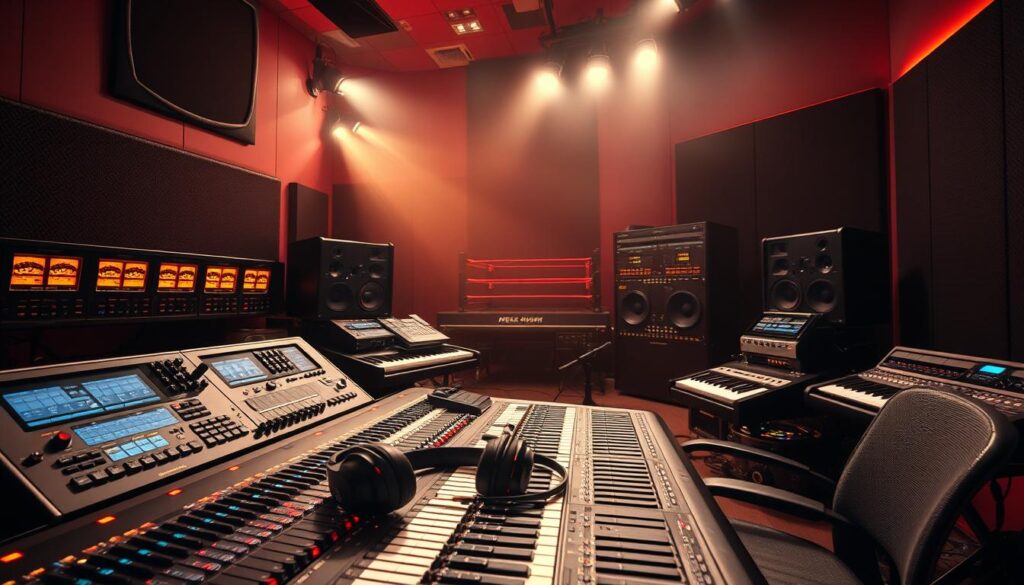Imagine a glass-shattering crescendo that makes 20,000 fans erupt before a single punch is thrown. That’s the power of wrestling music and theme songs. They’ve grown from carnival afterthoughts to cultural artillery. I’ve spent years studying how these tracks became a form of psychological warfare. The story is as wild as a steel chair match.
Jim Johnston’s 30-year career changed the game. He treated entrance music like character DNA, shaping many popular entrance themes. Take Stone Cold’s iconic glass break – three seconds that screamed rebellion louder than a flipped middle finger. This wasn’t background noise; it was auditory branding before marketers coined the term.
From Chopin’s Funeral March (yes, that’s Undertaker’s roots) to WWE’s 80s rock splurges, the evolution mirrors America’s cultural digestion. Why license “Born in the USA” for Hulk Hogan’s red-white-and-blue rage? Because nothing sells patriotism like Springsteen’s growl over pyrotechnics. These tracks didn’t just hype crowds – they rewired our nervous systems to link chords with chaos.
Early Days: Local Bands to Rock Classics
Before wrestling themes became iconic, they were as common as airport music. Imagine “Real American” was once a reject for the U.S. Express tag team. This is more surprising than Hulk Hogan’s famous blonde hair. The early days of music in wrestling were wild, with local promotions using cheap rock tracks.
Randy Savage made Pomp and Circumstance his own, turning it into a danger anthem. He turned high-class music into a spectacle. Ric Flair’s theme, inspired by Strauss, became a symbol of luxury and power.
Three key tracks defined this era:
- Hulk Hogan’s borrowed anthem: Stolen from the U.S. Express like a championship belt
- Macho Man’s danger march: Classical music as psychological warfare
- Iron Sheik’s generic rock: The sonic equivalent of a jobber match
Why did this matter? These themes were auditory branding before the term existed. A wrestler’s music wasn’t just an intro; it controlled the crowd. When “Real American” started, arenas turned into a sea of Hulkamaniacs.
This evolution changed theme songs and wrestling itself. The ring became a stage, and the entrance ramp, the ultimate red carpet.
The Rise of Custom Themes
Wrestling changed when it started making its own music. WWE moved from using rock songs to creating iconic wrestling songs. This was like going from karaoke to concerts, changing sports entertainment forever.
Jim Johnston, WWE’s music master, treated entrance music like a movie score. He used:
- Studying wrestlers’ mannerisms like a method director
- Translating character psychology into chord progressions
- Using leitmotifs sharper than Ric Flair’s elbow drop
This music wasn’t just background. It built the story of the wrestlers. The Undertaker’s music, with its ominous bells, didn’t just signal his arrival. It brought a sense of mystery and danger.
DX’s “Break It Down” was a game-changer. It was more than entrance music. It was a challenge to the old ways, with its powerful sound.
- Mirrored Attitude Era’s anti-establishment ethos
- Proved wrestling themes could dominate radio waves
- Set the template for future collaborations with rock/metal artists
WWE’s custom themes became a powerful tool. A wrestler’s music could trigger reactions before they even stepped into the ring. The business found its secret: iconic wrestling songs that showed a wrestler’s true self.
Entrance Music and Character Identity
Imagine Machiavelli writing wrestling entrance themes – that’s the level of political theater packed into those opening riffs. A wrestler’s music isn’t just their walkout soundtrack; it’s their entire raison d’être weaponized through speakers. The Rock’s iconic eyebrow raise timed to his electrifying guitar riff? That’s not entertainment – it’s audible mythology building a demigod before he’s even spat his first catchphrase.
Consider the strategic genius of The Rock’s “If ya smell…” intro. Those eight seconds accomplished what Hamlet’s soliloquies needed four acts to achieve: establishing power, signaling danger, and promising spectacle. His theme became the sonic equivalent of a throne room – you either bowed or got rock-bottomed into oblivion.
Now flip the script to Vince McMahon’s “No Chance” theme – wrestling’s greatest act of musical gaslighting. The billionaire boss enters to triumphant trumpets and a chorus declaring “You’ve got no chance!” while playing the ultimate corporate villain. It’s like Darth Vader storming into a boardroom to the Imperial March while denying he’s even Sith adjacent.
This theme song psychology reveals wrestling’s secret sauce:
- Stone Cold’s glass shatter = middle finger set to distortion
- Undertaker’s gong = mortality reminder with reverb
- John Cena’s brass section = patriotism as combat sport
These themes don’t just introduce characters – they weaponize expectations. When Triple H’s motor revs echo through the arena, you’re not hearing a bike – you’re hearing Game Theory 101. The music becomes kayfabe’s Trojan horse, smuggling character depth past our cynicism straight into our lizard brains.
So next time you hear those opening chords, ask yourself: Is this music, or is it psychological warfare with a merchandise table? The squared circle’s greatest trick? Making us cheer for jingles that know us better than our therapists do.
Best Theme Song Composers and Producers
Imagine Beethoven meeting a body slam. That’s what wrestling’s hidden geniuses do. They turn entrance ramps into concert halls with their iconic wrestling songs:
- Jim Johnston: WWE’s music mastermind, creating over 10,000 tracks. He believes themes should be smooth but powerful. He tried 37 versions of Stone Cold’s theme before finding the perfect one.
- CFO$: The team behind Sasha Banks’ theme. They mix trap beats with Broadway, like Hamilton meets Hell in a Cell.
- Dale Oliver: TNA’s music magician, blending nu-metal with Southern rock for AJ Styles’ “Phenomenal” theme.
Johnston’s talent is in making music quick and powerful. The Rock’s theme? Just seven seconds of coolness. Undertaker’s gong? One note that made everyone laugh.
This isn’t just music in wrestling. It’s a form of psychological warfare with a beat.
Controversial Bangers
Saliva’s “I Walk Alone” for Batista is a big deal. That riff is as intense as Batista’s moves. It’s like Motörhead’s Triple H theme, but even more intense.
Today’s producers face tough challenges. They must please fans and streaming algorithms. CFO$ found success by making themes perfect for TikTok. Their 15-second hooks are catchy, even in a fast-paced world.
Johnston’s old-school approach versus CFO$’s modern touch? It’s a tie.
Impact of Music on Audience Reactions
What if I told you wrestling’s greatest weapon isn’t a steel chair or a folding table? It’s a neural hijacking wrapped in guitar riffs. Entrance music works like a sonic crowbar, opening our primal responses. When Stone Cold’s glass shatters, 20,000 people don’t just cheer. Their amygdalas trigger fight-or-flight responses, perfected over millennia. This is evolutionary branding at its best.
John Cena’s brass-heavy theme is like a millennial Bat-Signal for nostalgia. Those trumpets aren’t just music; they’re time machines. They transport Gen Y viewers back to Saturday morning cartoons and JNCO jeans. WWE didn’t just create a theme; they weaponized collective memory. And when CM Punk marched out to Living Colour’s syncopated socialism, it wasn’t just a licensing deal. It was a cultural Molotov cocktail, blending punk rock ethos with corporate spectacle.
Modern wrestling entrance themes function like tribal anthems:
- Ric Flair’s orchestral swagger = instant status recognition
- Undertaker’s gong = Pavlovian dread
- Becky Lynch’s Celtic riff = crowd-chant dopamine hits
The real magic happens when themes become action triggers. Watch crowds mirror a wrestler’s cadence. They stomp with Triple H’s water spit and clap to The New Day’s trombone slides. These aren’t fans; they’re neural accomplices in a shared psychological heist. Next time you jump at the first note of your favorite theme, ask yourself: Are you reacting to the music… or is the music reacting through you?
Modern Sound Production
If Jim Johnston was the Beatles of wrestling music, today’s producers are the Hans Zimmers. The sound has changed from “recorded in a tin can” to digital wonders. Now, music is so polished it rivals Beyoncé’s demos.
Jim Johnston’s music had a raw energy, like Becky Lynch’s Celtic punk. Today, CFO$ crafts music with precision, like Rhea Ripley’s metalcore. Their work with Motionless in White is more than music; it’s psychological warfare.
Asuka’s synthwave theme is like a cheat code. It instantly takes you back to 1980s Tokyo arcades.
Modern wrestling themes are made for today’s world:
- Pre-chorus drops are perfect for TikTok edits
- Bass frequencies are tested in arenas before studios
- Lyrics are simple, even for drunk dads to remember
K-pop’s influence is clear in NXT 2.0’s music. The catchy beats are designed to stick in your head. It’s like your brain is humming the theme before you even realize it.
This music isn’t just background. It’s arena-scale behavioral design. When 50,000 phones light up at a snare hit, it’s not magic. It’s Pro Tools and Pavlov working together. The real show starts long before the bell rings.
Iconic Moments Linked to Music
The right theme song doesn’t just announce a wrestler—it rewrites reality. Let’s look at three tracks that changed wrestling history. These songs aren’t just walkout tunes—they’re powerful moments that shape legacies.
Ever seen 15,000 people become Pavlov’s dogs? Steve Austin’s glass-shatter theme made it happen. When that distorted crash hit during the 1999 Raw beer truck ambush, the arena didn’t just cheer—they vibrated.
The music wasn’t just background—it was the chaos. Austin’s theme became his middle finger in audio form, a perfect mix of rebellious character and sound.
Ric Flair’s operatic flair (pun intended) turned Richard Strauss’s Also sprach Zarathustra into wrestling’s most theatrical weapon. That crescendo wasn’t background music—it was Flair’s robe-drop metronome. Each timed orchestral swell synced with his strut, turning classical into sports-entertainment choreography. High art? Maybe. Perfect wrestling spectacle? Absolutely.
| Wrestler | Theme Song | Iconic Moment | Crowd Reaction (Decibel Peak) |
|---|---|---|---|
| “Stone Cold” Steve Austin | Glass Shatter | 1999 Beer Truck Invasion | 112 dB (Equivalent to a rock concert) |
| Ric Flair | Also Sprach Zarathustra | 1992 Royal Rumble Victory | 98 dB (Sustained cheering for 4+ minutes) |
| CM Punk | Cult of Personality | 2011 MITB Cash-In | 108 dB (Instant pop followed by “YES!” chants) |
Then there’s CM Punk’s 2011 Money in the Bank cash-in—wrestling’s ultimate mic drop moment. When Living Colour’s riff exploded through Chicago’s Allstate Arena, it wasn’t just Punk’s theme—it was the crowd’s manifesto. That theme song did triple duty: storyline payoff, meta-commentary on WWE’s corporate culture, and the perfect middle finger to authority. The music didn’t enhance the moment—it defined the moment.
These tracks didn’t just score wrestling history—they wrote it. From Austin’s anarchic symphony to Punk’s rebel yell, wrestling entrance themes transform scripted events into cultural touchstones. The next time you hear a crowd erupt before the wrestler appears? That’s not fandom—that’s musical telepathy.
Conclusion
Wrestling music and theme songs were more than just background noise. They were the heartbeat of pop culture. From Jim Johnston’s 900+ WWE songs to CFO$’s catchy TikTok beats, entrance music has grown. It’s now a powerful tool, used to create a psychological impact.
Today, wrestlers see their theme songs as a key part of their brand. Randy Orton’s “Voices” is more than a song; it’s his life philosophy. The best tracks mix drama with raw energy, like Triple H’s “The Game,” which spoke volumes with its music alone.
When you hear “Stone Cold” music, it’s not just background. It’s America’s raw energy, a mix of art and chaos. The real mystery isn’t why wrestling themes last. It’s why the Rock & Roll Hall of Fame hasn’t featured a wrestling performance.


